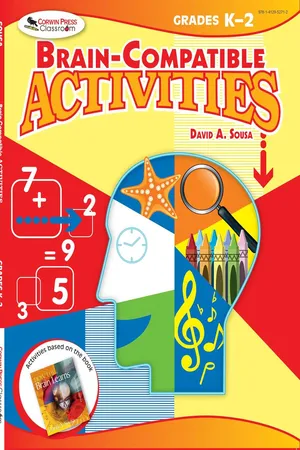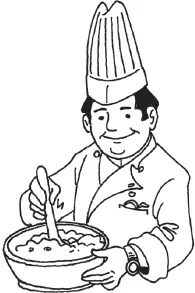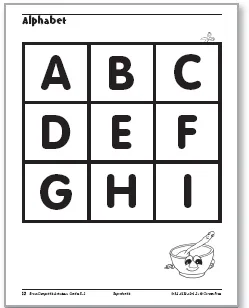
This is a test
- 96 pages
- English
- ePUB (mobile friendly)
- Available on iOS & Android
eBook - ePub
Brain-Compatible Activities, Grades K-2
Book details
Book preview
Table of contents
Citations
About This Book
Features 96 pages of brain testing and expanding quizzes and tests for children in grades K-2
Frequently asked questions
At the moment all of our mobile-responsive ePub books are available to download via the app. Most of our PDFs are also available to download and we're working on making the final remaining ones downloadable now. Learn more here.
Both plans give you full access to the library and all of Perlego’s features. The only differences are the price and subscription period: With the annual plan you’ll save around 30% compared to 12 months on the monthly plan.
We are an online textbook subscription service, where you can get access to an entire online library for less than the price of a single book per month. With over 1 million books across 1000+ topics, we’ve got you covered! Learn more here.
Look out for the read-aloud symbol on your next book to see if you can listen to it. The read-aloud tool reads text aloud for you, highlighting the text as it is being read. You can pause it, speed it up and slow it down. Learn more here.
Yes, you can access Brain-Compatible Activities, Grades K-2 by David A. Sousa in PDF and/or ePUB format, as well as other popular books in Education & Early Childhood Education. We have over one million books available in our catalogue for you to explore.
Information
Topic
EducationSubtopic
Early Childhood EducationCHAPTER 1
Language Arts
The human brain is not hardwired for reading. Our brains can master spoken language quickly. However, because the act of reading is not a survival skill, the brain requires explicit training in reading. Learning to read requires three neural systems and the development of skills that work together to help the brain decode abstract symbols into meaningful language. The visual processing system sees the printed word; the auditory processing system sounds out the word; and the frontal lobe integrates the information to produce meaning. It is a bidirectional and parallel process that requires phonemes be processed at the same time. Reading is testament to the brain’s remarkable ability to sift through input and establish meaningful patterns and systems.
Reading is one of the most difficult skills for the brain to master, and under current legislation, students must master it at earlier ages than ever. It is crucial, therefore, that you choose activities that capture students’ attention and promote retention. While the following activities are content-specific, they can be easily modified to fit your curriculum.
As the brain is developing skills to decode the meaning of sounds and symbols, it is creating semantic and syntactic networks that aid in communication. Verbal and written communication involves syntax and semantics to create meaning. The syntactic network uses the rules of language, or grammar. The semantic network combines the components of language and the mind’s search for meaning. The brain holds two separate stores for semantics, one for verbally based information and another for image-based information. Using concrete images to teach abstract concepts will greatly increase retention. The brain builds on speaking skills to develop and refine all language abilities—speaking, reading, writing, and grammar.
“There are no areas of the brain that specialize in reading. Reading is probably the most difficult task we ask the young brain to undertake.”
Blending Bowl
Standard
Apply a wide range of strategies to comprehend, interpret, evaluate, and appreciate texts. Draw on prior experience, interactions with other readers and writers, knowledge of word meaning and of other texts, word identification strategies, and understanding of textual features (e.g., sound-letter correspondence, sentence structure, context, graphics).
Objective
Students will orally blend phonemes to form words.
Anticipatory Set
Gather ingredients to make brownies (find a recipe in a kid-friendly cookbook or online). Place the individual ingredients on a table so all students can see. Have the students name each ingredient as you place it in a large mixing bowl. While mixing the ingredients together, ask students to think about what might happen to the ingredients. Invite students to share their thoughts with a partner. Then show them the batter that resulted from blending of the individual ingredients.

Purpose
Remind students that they have been learning the individual sounds associated with letters of the alphabet. Tell them they are going to see what happens when these individual sounds mix together to form something new. Like the ingredients blended together to form the brownie batter, letter sounds can also blend together. When letters blend together they form words. Today you are going to practice blending letter sounds together to form words.
Input
Tell students that words are made up of individual sounds. Show them how they can figure out the individual sounds of a word by looking at each letter in the word. The letter sounds blend together to form the word. Tell students that reading is just mixing the letter sounds together!
Modeling
Before the activity, reproduce the Alphabet reproducibles (pages 12–15) on cardstock. Cut out the word and letter cards. Hide the word cards in the bottom of a bowl. In front of the class, place the letter cards c, a, and t individually in the bowl. Have students identify the sound of each letter as you drop it into the bowl. Stir the letters with a spoon and pull out the card with the word cat. Blend the sounds together orally for students, and have them repeat the blending after you. Repeat the activity with different letter cards and the resulting words.

Alphabet Page 12
Check for Understanding
Place more letters in the bowl; stir them together; pull out the letters; and write them on a card. Ask students to look at the card and blend the letters together silently in their heads. Have students share the blended word with their partners and encourage them to praise one another for correct responses. Repeat several times, and observe each student pair to assess understanding.
Guided Practice
Before guided practice, reproduce the Alphabet reproducibles used earlier, and ask a volunteer to cut out the letters. Give each pair of students a small bowl and a set of individual letter cards. Have students place the letter cards in the bowl and stir them with a spoon. Give students a copy of the Blending Bowl Word List reproducible (page ...
Table of contents
- Cover
- Title Page
- Copyright
- Table of Contents
- Connections to Standards
- Introduction
- Put It Into Practice
- Chapter 1: Language Arts
- Chapter 2: Mathematics
- Chapter 3: Social Studies
- Chapter 4: Science
- Chapter 5: Physical Education and The Arts
- References